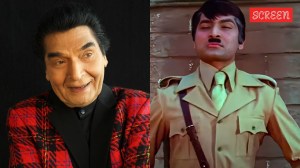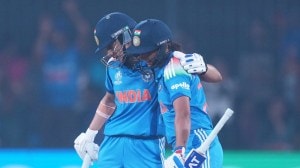Stay updated with the latest - Click here to follow us on Instagram
Bangladesh violent protests leave 19 dead: Here’s what happened today
The new casualties Thursday would bring the overall toll to 25 dead since Monday when violence erupted at the prestigious Dhaka University in the capital.
 Police fire tear gas shells and rubber bullets to disperse students shouting slogans in favor of quota system in public service at the university campus, in Dhaka, Bangladesh, Wednesday, July 17, 2024. (AP Photo/Rajib Dhar)
Police fire tear gas shells and rubber bullets to disperse students shouting slogans in favor of quota system in public service at the university campus, in Dhaka, Bangladesh, Wednesday, July 17, 2024. (AP Photo/Rajib Dhar)
At least 19 people were killed in Bangladesh on Thursday after the protests over quota system in government jobs turned violent, taking the total number of casualties to at least 25. About 2,500 more were also injured in the clashes between the students and the police.
Violence first erupted on Monday at the Dhaka University in the capital and soon spread to other cities. Six people were reported to be killed on Tuesday, and hundreds more injured.
Authorities did not immediately confirm figures for the deaths.
The majority of the deaths were reported in Dhaka, where protesters clashed with police and activists from the ruling Awami League party. Dhaka-based newspaper Prothom Alo said at least six people died in Dhaka’s Uttara area alone in the latest clashes pitting the protesters against security officials and ruling party activists.
Another newspaper Dhaka Tribune identified one victim as Farhanul Islam Bhuyian, who died from a chest wound during a clash in Dhanmondi. City Hospital doctors reported treating numerous patients with similar injuries, including a 10-year-old with 12 pellets lodged in his body.
 The violence first erupted on Monday at Dhaka University, the country’s leading public university, where over 100 students were injured in clashes between protesters and members of the student wing of the ruling Awami League party, the Bangladesh Chhatra League (BCL). (AP Photo/Abdul Goni)
The violence first erupted on Monday at Dhaka University, the country’s leading public university, where over 100 students were injured in clashes between protesters and members of the student wing of the ruling Awami League party, the Bangladesh Chhatra League (BCL). (AP Photo/Abdul Goni)
The violence spread beyond Dhaka, claiming lives in Narayanganj and Chittagong. Among the dead are 15-year-old Tahmid Tamim and 22-year-old M Imon Mia from Narayanganj, and 18-year-old student Mohammad Imad from Potiya Government College Higher Secondary in Chittagong.
Bangladesh’s state broadcaster, Bangladesh Television (BTV), reported a fire set by protesters at their headquarters, describing it as “catastrophic” and “spreading fast”. An anonymous official from the station told AFP that hundreds of protesters had entered the building and set vehicles and offices on fire.
Dhaka Times journalist Hasan Mehedi also died after being brought in with gunshot wounds from the Kajla area, highlighting the dangers faced by media personnel caught in the crossfire.
 At Jahangir Nagar University, protesters had gathered in front of the vice-chancellor’s residence early Tuesday when they were attacked by BCL activists and police, according to witnesses. (AP Photo/Abdul Goni)
At Jahangir Nagar University, protesters had gathered in front of the vice-chancellor’s residence early Tuesday when they were attacked by BCL activists and police, according to witnesses. (AP Photo/Abdul Goni)
Stalled talks and government measures
The government, led by Prime Minister Sheikh Hasina, has offered to engage in dialogue with the protesters. Law Minister Anisul Huq has reiterated their willingness to discuss quota reform.
However, student leaders like Hasnat Abdullah and Asif Mahmud has rejected these offers and argued that negotiations cannot take place amid violence and bloodshed. They have demanded that the government address their core concerns, which include reforming the quota system, ensuring university safety, and punishing those responsible for the deaths.
Adding fuel to the fire, the government has imposed restrictions on mobile internet access. Junior Information Technology Minister Zunaid Ahmed Palak cited “rumors” and an “unstable situation” on social media as justification. Netblocks, a digital rights organization, reported a “near-total national internet shutdown”. Media rights groups have decried this “internet blackout” as a further attempt to stifle dissent.
Meanwhile, Indian authorities advised its nationals and students in Bangladesh to limit their movements outside their residences in light of the ongoing quota-related violence across the country. The advisory includes 24-hour emergency contact numbers for those needing assistance.
 The unrest has also taken on a political dimension, with the main opposition Bangladesh Nationalist Party (BNP) and its student wing calling for marches on Wednesday to protest the attacks on the anti-quota protesters. (AP Photo/Abdul Goni)
The unrest has also taken on a political dimension, with the main opposition Bangladesh Nationalist Party (BNP) and its student wing calling for marches on Wednesday to protest the attacks on the anti-quota protesters. (AP Photo/Abdul Goni)
The death toll is expected to rise as clashes continue into the night. With communication disrupted and protests ongoing, it remains unclear if a peaceful resolution can be reached. The student leaders have vowed to continue their demonstrations until their demands are met, raising concerns about further violence and instability in Bangladesh.
The protests were triggered when the High Court reinstated a quota system reserving 30% of government jobs for descendants of 1971 independence fighters. The quota system has gone through several changes since being introduced in 1972. When it was abolished in 2018 after similar student protests, 56% of government jobs were reserved under various quotas. The current protesters want all categories abolished except for indigenous communities and the disabled.
The protesters argued the quota system is discriminatory and benefits supporters of Prime Minister Sheikh Hasina’s party, which led the independence movement. They wanted a merit-based system instead.





- 01
- 02
- 03
- 04
- 05


























